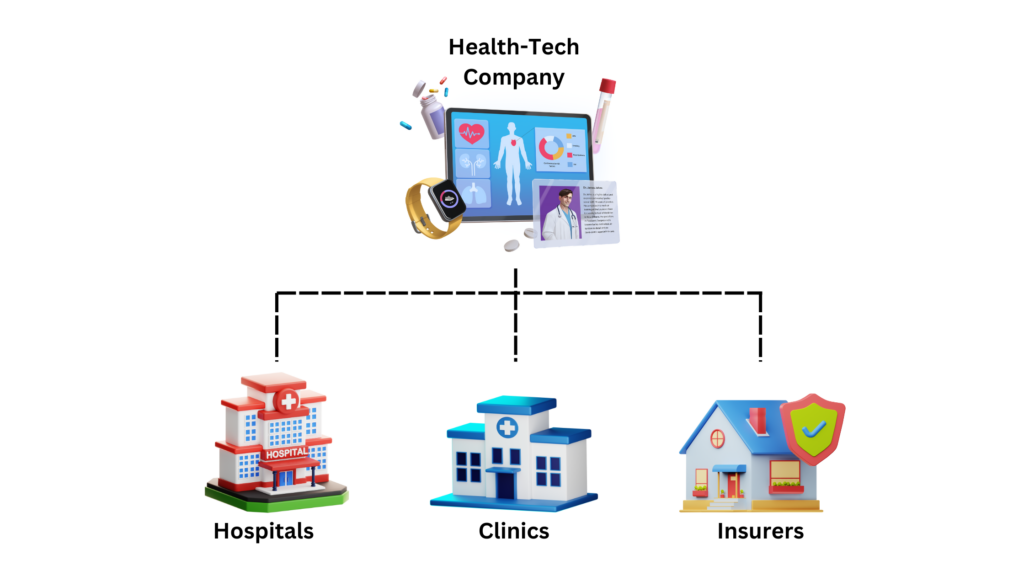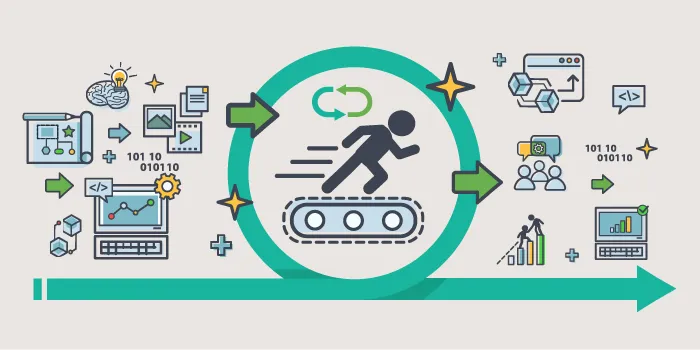As the healthcare industry continues to evolve, technology is reshaping the way we diagnose, treat and manage health. Health-tech startups are at the forefront of this innovation, but to succeed in this dynamic environment, choosing the right business model is important. In this guide, we will explore the various business models within the health-tech space, providing insights for entrepreneurs, innovators and business leaders.
StrategyConnect’s consultants have worked with many health-tech companies, including pioneering startups in biosensors and personalized health, helping them navigate the market and business landscape of healthcare technology.
The B2B (Business to Business) Model
The B2B model is one of the prevalent models in health-tech. Companies using this model typically develop solutions, whether it is software, hardware or a hybrid; and sell them directly to healthcare providers, hospitals, clinics or insurers. This commonly happens through different tools like customization, support and training, developing solutions for scalability etc.

Key to Success
The key to success in B2B business models lies in building strong, long-term relationships with clients. This requires a deep understanding of their needs, providing tailored solutions and ensuring excellent customer support.
In healthtech, for example, a company developing innovative biosensors must focus on integrating its technology smoothly into hospital systems and providing training and support to healthcare professionals to maximize the technology’s benefits and foster lasting partnerships.
Appropriate For
B2B models are particularly suitable for companies that provide specialized products or services requiring integration into other businesses’ operations. This includes industries such as technology, manufacturing and professional services, where solutions need to be tailored to specific client needs. For example, in healthtech, a company developing electronic health record (EHR) systems can sell their software directly to hospitals and clinics, providing customized support and integration to enhance patient care and operational efficiency.
Pricing Models
The most common pricing models in B2B business include subscription-based, tiered pricing and per-user or per-device fees.
The B2C (Business to Consumer) Model
Health-tech companies can also sell directly to consumers, offering solutions or services that empower individuals to monitor and manage their health. This model has gained traction with the rise of wearables and mobile health apps. However, it is a highly competitive market, and success depends on user experience, regulatory approvals and data security.

Key to Success
Success in B2C business models hinges on understanding consumer needs, offering exceptional user experiences, and fostering strong brand loyalty. Companies must focus on personalized marketing, seamless omnichannel presence and continuous innovation. High-quality products and excellent customer support are crucial for retaining customers and encouraging repeat business. Fitbit, which offers wearable fitness trackers directly to consumers. Fitbit has built a loyal customer base by providing user-friendly devices and a robust app ecosystem for health monitoring and wellness.
Appropriate For
B2C models are ideal for businesses that offer products or services directly to consumers. This includes industries like retail, entertainment, travel and personal care. Companies in these sectors benefit from direct interactions with their customers, enabling personalized marketing and tailored offerings. Healthtech companies, particularly those offering wearable health devices or mobile health apps, are well-suited to the B2C model.
Pricing Models
Pricing models in B2C business include subscription-based, freemium, one-time purchase and/or in-app purchases. These models attract and retain consumers by offering flexibility and value. Subscription and freemium models drive recurring revenue, while one-time and in-app purchases offer immediate revenue opportunities.
Case in point
StrategyConnect worked with a company focused on developing advanced biosensors for health applications. Based in the UAE, we helped them unlock the full potential of their product and accordingly developed a strategic business for their market launch. To know more about this case, click here.
The B2B2C (Business to Business to Consumer) Model
This is a hybrid model that is gaining popularity in Health-tech. A company creates a product or service, which is sold to businesses (such as healthcare providers or insurers), who in turn offer the product to their patients or customers. It blends elements of both B2B and B2C.

Key to Success
Success in B2B2C models relies on building strong partnerships with intermediary businesses and ensuring seamless integration into their systems. Effective communication, tailored solutions and robust support are crucial. Additionally, maintaining a focus on end-user experience and continuously improving based on feedback can drive long-term success. Teladoc Health is a great example. It provides telehealth services through partnerships with employers and insurance companies, offering their employees and policyholders access to virtual healthcare, which enhances reach and trust.
Appropriate For
B2B2C models are ideal for companies that create products or services needing distribution through other businesses to reach the end consumer. This model suits industries like technology, financial services and healthcare, where products benefit from the endorsement and distribution capabilities of established businesses. B2B2C is particularly effective for companies offering complex solutions that require intermediary endorsement before reaching consumers.
Pricing Models
The most common pricing models in B2B2C business include subscription-based, tiered pricing and value-based pricing. These models cater to different segments and usage levels, providing flexibility. Additionally, usage-based pricing, which charges based on consumption, and per-user pricing, aligning costs with the number of end-users, are also frequently employed.
Case in Point
Recently, StrategyConnect worked with a UK-based personalized well-being platform that allows users to create custom wellness journeys. We identified the company’s B2B client’s employee challenges, such as a lack of long-term strategy and unclear goals and created various detailed strategies for marketing, operations, pricing etc.
The SaaS (Software as a Service) Model
SaaS has become a dominant business model in Health-tech, where companies offer software solutions via subscription or online platforms. It provides healthcare organizations with continuous updates, support, and scalability. SaaS models are particularly useful in areas like electronic health records (EHR) and telemedicine platforms.

Key to Success
Success in SaaS business models relies on delivering continuous value through regular software updates, robust customer support and high levels of data security and compliance. Building a scalable, user-friendly platform is essential, along with understanding and adapting to customers’ evolving needs. A notable example is Epic Systems, which provides electronic health record (EHR) solutions. Epic’s SaaS model ensures healthcare providers receive constant software improvements and support, enhancing patient care and operational efficiency.
Appropriate For
SaaS models are particularly suitable for businesses that provide software solutions requiring continuous updates and support. This includes industries such as technology, finance, education and healthcare. SaaS platforms benefit from recurring revenue streams and can scale easily to accommodate growing user bases. Companies that offer cloud-based services, project management tools, and customer relationship management (CRM) systems thrive under this model. In healthtech, for example, a company providing electronic health record (EHR) systems can use the SaaS model to offer healthcare providers continuous software updates, support, and scalable solutions, ensuring improved patient care and streamlined operations.
Pricing Models
Common pricing models in SaaS include subscription-based, tiered pricing, freemium, and pay-per-use. Subscription ensures recurring revenue; tiered pricing offers different service levels; freemium attracts users with basic free access, while premium features are paid; pay-per-use charges based on actual usage.
Case in point
A San Francisco-based non-profit tech startup specializing in utilizing mobile technology for real-time environmental monitoring, developed bioacoustics monitoring platform. With the help of StrategyConnect’s consultants, the startup successfully positioned itself for market expansion through a value-enhancing acquisition and improved its financial narrative to stake holders.
Conclusion: Choosing the Right Model for Your Health-tech Venture
The choice of business model can determine the success or failure of a health-tech company, or any company for that matter. By understanding the intricacies of each model and aligning it with your product or service, you can better position your company for long-term growth and sustainability.
At StrategyConnect, we’ve helped startups as well as established health-tech companies navigate these choices, from biosensors to software platforms. If you’re a health-tech entrepreneur looking to scale your business or optimize your product’s market fit, you are in the right place.
To connect with top-tier HealthTech consulting experts, like those featured in our case study, reach out to us at hello@strategyconnect.co or explore our services at https://www.strategyconnect.co/





